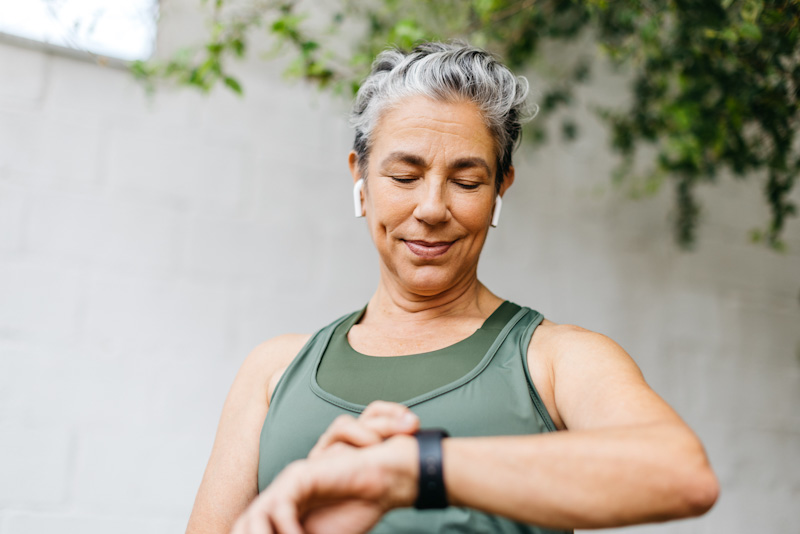You don’t have to own a fitness tracker, smartwatch or other activity-monitoring device to know about the importance of the number 10,000.
This aspirational target has become widely accepted as the number of steps we are supposed to walk in a day, entering the public consciousness in recent years as wearable technology has grown in popularity.
Despite its recent surge in profile, the mythical 10,000 figure actually dates back to 1964, and it is rooted not in medical science but in a marketing campaign for a pedometer. The product, promoted prior to the Tokyo Olympics, was called the Manpo-kei – a name constructed from the words for ‘10,000’, ‘steps’ and ‘meter’. Reportedly, 10,000 was chosen because in Japanese script, the figure representing this number resembles a person walking.
Having since been absorbed into history, the idea of ‘getting your steps in’ is now part of everyday conversations. In 2024, more than a third of UK adults (35%) are thought to own and use a wearable device, and the market is poised to grow by a further 10% worldwide this year as people increasingly embrace technology’s role in managing their health.
Optimising activity for health benefits
The idea that clocking up 10,000 steps leads to protective health benefits is, in fact, reinforced by research. One study points to 9,800 steps as being the ‘optimal dose’ for delivering a 50% reduction in the risk of dementia. Others point to benefits in relation to cardiovascular disease, cancer and stroke as well as mental health conditions such as anxiety and depression.
And even when you’re not reaching the full 10,000, studies have shown that health benefits can be gained when activity levels are increased, leading some experts to advise that walking more is, within reason, better for you.
As wearable technology has become increasingly ubiquitous, growing numbers of people are equipping themselves with the means to evidence their activity levels. Furthermore, as the technology becomes more sophisticated, this data goes beyond the simple number of steps walked to include measures of heart rate, blood oxygen saturation, calories burned and sleep quality.
The value of health data
These indicators of activity and health are no doubt of interest at a personal level, but they can also be seen as highly valuable. By adding colour and detail to the picture of an individual’s overall health risk, health data has the potential to influence how much you pay when it comes to healthcare insurance.
This point is highlighted by insurer Vitality, which allows scheme members to turn physical activity data, such as working out at a partner gym, joining a parkrun, or using a linked activity tracking device, into reward points. These can be used to offset repayments on a smart device, such as an Apple Watch, or to access discounts on health and wellbeing products and services.
Going one step further, the insurer has also launched a proposition for life, serious illness and income protection where monthly premiums are influenced by activity levels tracked by a policyholder’s Apple Watch.
And in the US, a major provider of life insurance, John Hancock, previously announced that it would not offer policies that did not incorporate gathering data from digital fitness trackers.
It is worth underlining, however, that activity data is only likely to form part of the picture when it comes to calculating premiums. Insurers will also want to understand details about an individual’s underlying health, their family history, their physical condition and their lifestyle habits when looking to establish their overall risk level.
Tech as an engagement tool
For employers, subsidising investment in trackers can help employees overcome financial barriers to accessing the technology required to monitor and measure physical activity. This can support greater engagement with personal health and wellbeing which, in turn, can encourage individuals to make positive choices and improvements to health, while also opening the door to incentivisation through activity-based points and rewards.
This has the potential to result in a win-win situation, both helping individuals in their own wellbeing and also helping protect against physical conditions that might lead to absence and lost productivity.
It has been said that what can’t be measured can’t be improved. Today, wearable devices already give us instant access to more personal health data than we might have ever thought possible so, as they continue to evolve, we can only expect their potential as a force for good to be enhanced.
The information contained within this communication does not constitute financial advice and is provided for general information purposes only. No warranty, whether express or implied is given in relation to such information. Vintage Health or any of its associated representatives shall not be liable for any technical, editorial, typographical or other errors or omissions within the content of this communication.





